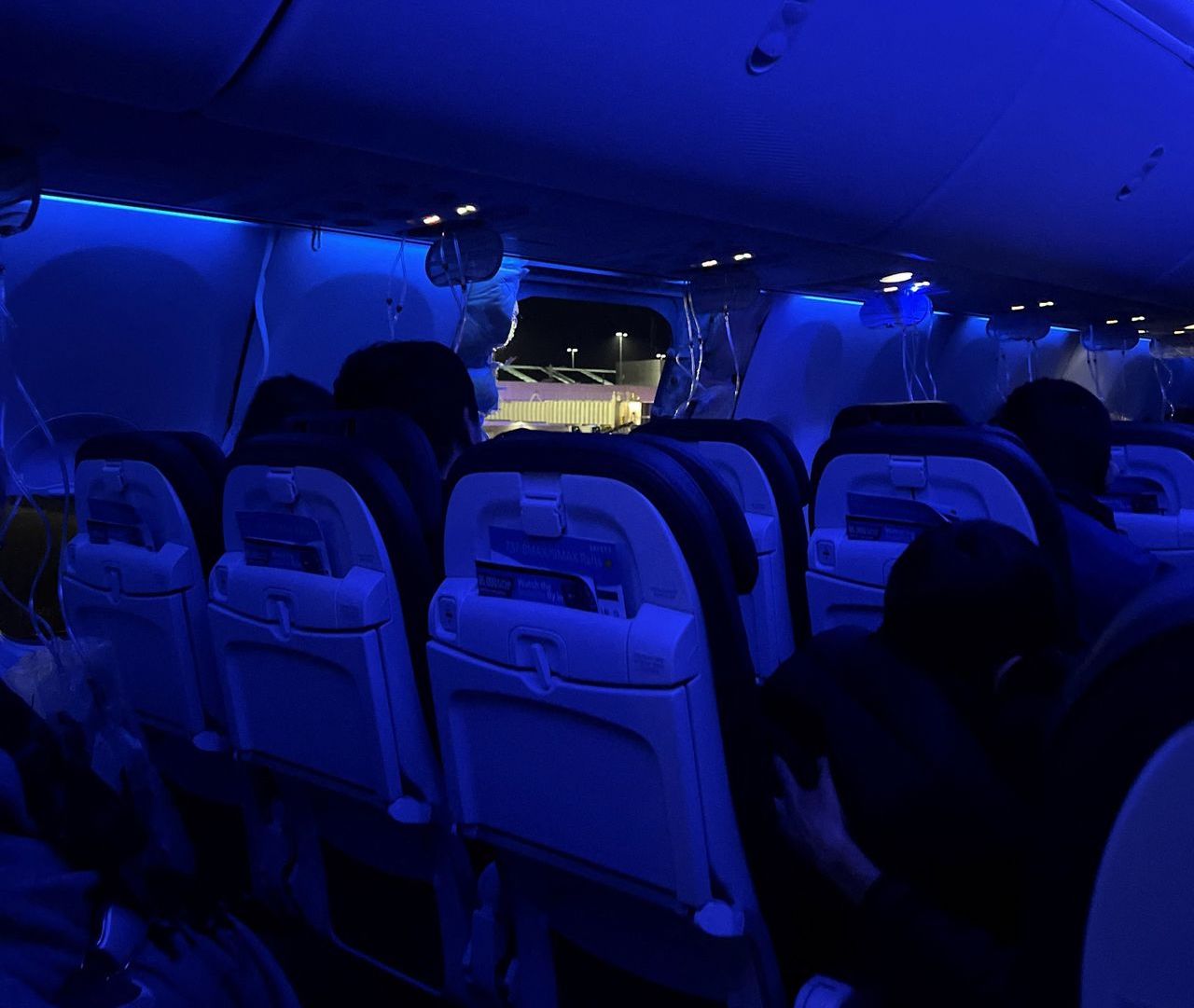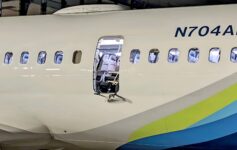
New revelations about what occurred onboard Alaska Airlines flight 1282, operated by a Boeing 737-9 MAX, paint a more concerning picture of the terrifying incident that led to a nationwide grounding of this jet type for further inspections.
Preliminary Investigation Reveals Irregularities On Alaska Airlines 737-9 MAX Flight
The aircraft type was involved in a freak incident over Portland, Oregon on Friday, January 5, 2024. A “plugged” rear mid-cabin emergency exit door on an Alaska Airlines 737-9 MAX (essentially, part of the fuselage) separated from the aircraft minutes after takeoff, triggering a rapid decompression event. An emergency was declared and the aircraft returned to Portland. No injuries were reported.
> Read More:Alaska Airlines 737-9 MAX Exit Door Separates From Aircraft After Takeoff, Forcing Emergency Landing
> Read More:FAA Grounds Boeing 737 MAX 9 Jets
The National Transportation Safety Board (NTSB) is investigating.
Diagram of a Boeing 737-9 mid-cabin door plug and components (Source: Boeing) pic.twitter.com/7qPF5MGAOX
— NTSB Newsroom (@NTSB_Newsroom) January 8, 2024
Further facts have emerged about what occurred onboard which are quite concerning:
- On three prior flights, this aircraft’s (registration number N704AL) auto pressurization fail warning light came on in the flight deck:
- December 7, 2023
- January 3, 2024
- January 4, 2024
- It was for this reason this aircraft was pulled off ETOPS (overwater) service
- Alaska 1282 was initially delayed by about 20 minutes in Portland (PDX) for de-icing
- Passengers reported a loud “bang” and jolt in the cabin when the door plug separated from the fuselage, though it was not clear for those in the front of the aircraft what had happened
- The cockpit door flung open and jammed into the lavatory door (which was empty)
- A quick reference checklist flew out of the cockpit door
- The first officer jolted forward and his headset flew off
- The circuit breaker to the cockpit voice recorder was not pulled, so the recorder was empty
- Not only seat 26A, but 26B were open (the location of the blowout)
- The decompression pulled the cushions off the seats and also the tray table off 26A
- Oxygen masks did not properly deploy in all seats
- “Additional damage” occurred in rows 1 through 4, 11 and 12, 25 through 27 and 31 through 33
- The extent and nature of the damage is not clear
The plug, as well as two mobile phones that flew out, have been located in the backyard of a Portland home.
What’s next? Per NPR:
NTSB teams spent Sunday documenting damage to the frame. They have looked for paint transfers and are sending some components, such as the stop fittings, to a laboratory to be examined, where the NTSB will search for things like fractures and shears under a microscope.
There is not necessarily a correlation between the prior auto-pressurization warning lights and the incident last Friday. Even so, the totality of the emerging facts suggests that Alaska may have been cavalier in not getting to the root of that issue in a more timely manner.
CONCLUSION
The jolt from the fuselage separation of Alaska Airlines 1282 was sufficient to send the reinforced cockpit door flying open and jam it into the lavatory door outside. It appears that not all oxygen masks were properly deployed and this particular aircraft was not without prior issues.
I will not speculate further here beyond saying I am very thankful that this did not happen at a higher altitude. Can you imagine if this occurred at 35,000 feet when the seatbelt light was off?
image: Instagram / @strawberrvy




How long until the 900ERs are pulled? Assuming that the plugs are of the same design (which they likely are). Better have a backup if you’re on AS, DL or UA in the next few weeks.
Fine to inspect them of course, but with over 500 900ERs in the world, many of which are over 10 years old, it seems that the likely explanation here is that this isn’t an issue with the design of the plug, The plane that blowout was a newer plane if I recall correctly and thus I can’t help but wonder if it was an installation problem.
So three prior pressure alerts (within days) and Alaska thought okay we’ll just keep flying it as long as we can get it back on the ground quickly? No. It’s airworthy or it’s not. Practically a miracle no one was seriously hurt.
@Maryland … +1 .
Alaska has some explaining to do. As for the cockpit door opening, that also needs looked at.
Absolutely amazing this wasn’t a worse tragedy.
Boeing took a $23 hit at opening and ended down around $20. Opportunity?
According to reports elsewhere on Boarding Area (PYOK) the cockpit door opening was by deliberate design – which was NOT communicated by Boeing to either pilots or NTSB. Shades of MCAS again…
Yes, that has been confirmed – interesting way to gain access to the cockpit, isn’t it?
It certainly is, especially if you don’t care about the long-term 🙁
I can see some reasons for the decision (though would prefer small blow-out plugs to equalise pressure). But to not disclose this to flight crew seems to be another “we know better” from Boeing!
And I’ve just realised – Helios 422 was a 737… when did this design decision first apply?
Correction – Helios 522
What are the chances that 2 seats together by the plugged door were empty? Was Alaska airlines blocking these seats?
EXCELLENT question!! I smell lawsuit.
Were they empty on the other side of the plane adjacent to the other plug?
The two individuals assigned to sit there apparently missed their connection in PDX, talk about serendipity.
https://theaircurrent.com/feed/dispatches/united-finds-loose-bolts-on-plug-doors-during-737-max-9-inspections/
If the above linked report is accurate, it appears United have found ‘discrepant bolts and other parts’ on at least 5 of their aircraft.
I wonder what the ‘other parts’ were?
probably the wings
Further proof that you should keep a seatbelt on at all times when not needing to use the lavatory. Miraculous someone didn’t get sucked out the aircraft.
Pressure in high altitude wouldn’t allow the door to blow open, it would on descent though.